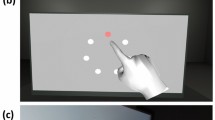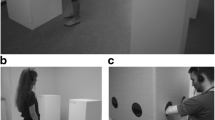Abstract
In this paper, we study the interactional organization of an instructed object exploration among sighted and visually impaired people (VIPs) in order to contribute to studies of instructional activities and the observable accomplishment of haptic perception. We do this by showing the situated, interactional, and co-operative organization of achieving object understanding. We focus on the dynamics of haptic perception as being reliant on instructions, while at the same time being an observable production that furnishes further instructions. We show the organization of visual and verbal instructions versus the touching of objects for haptic perception. Based on ethnomethodological conversation analysis of video data, we study a VIP’s haptic actions in interaction with a professional, sighted ICT consultant who provides instructions on what an object is and what it can do. We show how the instructions are sequentially adjusted to make them relevant for a simultaneous, emerging exploration in which the VIP uses their hands and fingers to perceive very specific details of the object. We argue that achieving object understanding is accomplished in and through the fine-tuned coordination of haptic exploration, both as a response to verbal instructions and also as a means of conveying perception-related actions, which the ICT uses to build new actions. The paper thus makes a case for instructed and distributed haptic perception as observable in social interaction and as a resource for building object understanding within phenomenal fields.
Similar content being viewed by others
References
Arnheim, R. (1990). Perceptual aspects of art for the blind. Journal of Aesthetic Education, 24(3), 57–65. https://doi.org/10.2307/3332799
Coulter, J., & Parsons, E. D. (1990). The praxiology of perception: visual orientations and practical action. Inquiry, 33(3), 251–272. https://doi.org/10.1080/00201749008602223
Cuffari, E., & Streeck, J. (2017). Taking the world by hand: how (some) gestures mean. In Intercorporeality: Emerging Socialities in Interaction. Oxford University Press. http://www.oxfordscholarship.com/view/https://doi.org/10.1093/acprof:oso/9780190210465.001.0001/acprof-9780190210465-chapter-7
Day, D., & Wagner, J. (Eds.). (2019). Objects bodies and work practice. Multilingual Matters.
De Stefani, E., & Gazin, A.-D. (2014). Instructional sequences in driving lessons: mobile participants and the temporal and sequential organization of actions. Journal of Pragmatics, 65, 63–79. https://doi.org/10.1016/j.pragma.2013.08.020
Deppermann, A. (2019). Intersubjectivity and other grounds for action-coordination in an environment of restricted interaction: Coordinating with oncoming traffic when passing an obstacle. Language & Communication, 65, 22–40. https://doi.org/10.1016/j.langcom.2018.04.005
Due, B. L. (2021a). Distributed perception: co-operation between sense-able, actionable, and accountable semiotic agents. Symbolic Interaction, 44(1), 134–162. https://doi.org/10.1002/symb.538
Due, B. L. (2021b). Interspecies intercorporeality and mediated haptic sociality: Distributing perception with a guide dog. Visual Studies. https://doi.org/10.1080/1472586X.2021.1951620
Due, B. L. (2022). Guide dog versus robot dog: assembling visually impaired people with non-human agents and achieving assisted mobility through distributed co-constructed perception. Mobilities. https://doi.org/10.1080/17450101.2022.2086059
Due, B. L., & Lange, S. B. (2018). Troublesome objects: unpacking ocular-centrism in urban environments by studying blind navigation using video ethnography and ethnomethodology. Sociological Research Online, 24(4), 475–495. https://doi.org/10.1177/1360780418811963
Eisenmann, C., & Lynch, M. (2021). Introduction to Harold Garfinkel’s ethnomethodological “Misreading” of Aron Gurwitsch on the phenomenal field. Human Studies, 44(1), 1–17. https://doi.org/10.1007/s10746-020-09564-1
Emirbayer, M., & Maynard, D. W. (2011). Pragmatism and ethnomethodology. Qualitative Sociology, 34(1), 221–261. https://doi.org/10.1007/s11133-010-9183-8
Fele, G. (2008). The phenomenal field: ethnomethodological perspectives on collective phenomena. Human Studies, 31(3), 299–322. https://doi.org/10.1007/s10746-008-9099-4
Garfinkel, H. (2002). Ethnomethodology’s program: working out Durkheim’s aphorism. Rowman & Littlefield Publishers.
Garfinkel, H. (1991). Respecification: evidence for locally produced, naturally accountable phenomena of order, logic, reason, meaning, methods, etc. In and of the essential haecceity of immortal ordinary society (I)—An announcement of studies. In G. Button (Ed.), Ethnomethodology and the Human Sciences (pp. 10–19). Cambridge University Press.
Gibson, J. J. (1962). Observations on active touch. Psychological Review, 69, 477–491. https://doi.org/10.1037/h0046962
Gibson, J. J. (1979). The ecological approach to visual perception. Houghton Mifflin.
Goodwin, C. (1994). Professional vision. American Anthropologist, 96(3), 606–633.
Goodwin, C. (1995). Seeing in depth. Social Studies of Science, 25(2), 237–274.
Goodwin, C. (2000). Action and embodiment within situated human interaction. Journal of Pragmatics, 32(10), 1489–1522.
Goodwin, C. (2007). Participation, stance and affect in the organization of activities. Discourse and Society, 18(1), 53–74.
Goodwin, C. (2017). Co-operative action. Cambridge University Press.
Goodwin, C., & Smith, M. S. (2020). Calibrating professional perception through touch in geological fieldwork. In Touch in Social Interaction. Routledge.
Gurwitsch, A. (1964). The field of consciousness. Duquesne University Press.
Hausendorf, H. (2003). Deixis and speech situation revisited. The mechanism of perceived perception. In F. Lenz (Ed.), Deictic conceptualisiation of space, time and Person (pp. 249–269). Benjamins.
Hausendorf, H. (2003a). 11. Deixis and speech situation revisited. Pbns.112.13hau; John Benjamins Publishing Company. https://benjamins.com/catalog/pbns.112.13hau.
Hazel, S., & Mortensen, K. (2014). Embodying the institution—object manipulation in developing interaction in study counselling meetings. Journal of Pragmatics, 65, 10–29. https://doi.org/10.1016/j.pragma.2013.11.016
Heath, C., Hindmarsh, J., & Luff, P. (2010). Analysing video: Developing preliminary observations. Video in Qualitative Research: Analysing Social Interaction in Everyday Life, 61–86.
Hindmarsh, J., Reynolds, P., & Dunne, S. (2011a). Exhibiting understanding: the body in apprenticeship. Journal of Pragmatics, 43(2), 489–503.
Hofstetter, E. (2021). Analyzing the researcher-participant in EMCA. Social Interaction. Video-Based Studies of Human Sociality. https://doi.org/10.7146/si.v4i2.12718
Hull, J. M. (1997). On sight & insight: A journey into the world of blindness. Oneworld.
Hull, J. M. (2013). Touching the rock: An experience of blindness. SPCK. http://ebookcentral.proquest.com/lib/kbdk/detail.action?docID=1184965.
Husserl, E. (1982). General introduction to a pure phenomenology. M. Nijhoff .
Ingold, T. (2000). The perception of the environment: Essays on livelihood. Psychology Press.
Jenkings, N. K. (2017). Rock climbers’ communicative and sensory practices: intercorporeality, interkinesthesia, and enaction in sports. In C. Meyer & U. V. Wedelstaedt (Eds.), Moving bodies in interaction –interacting bodies in motion intercorporeality, interkinesthesia, and enaction in sports (pp. 149–172). John Benjamins.
Jonas, H. (1953). The nobility of sight. Philosophy and Phenomenological Research, 14(4), 507–519. https://doi.org/10.2307/2103230
Keevallik, L. (2013). Here in time and space: Decomposing movement in dance instruction. In Here in time and space: Decomposing movement in dance instruction (pp. 345–370). De Gruyter. https://doi.org/10.1515/9783110291278.345.
Kendrick, K. H., & Drew, P. (2016). Recruitment: offers, requests, and the organization of assistance in interaction. Research on Language and Social Interaction, 49(1), 1–19. https://doi.org/10.1080/08351813.2016.1126436
Kennedy, J. M., Gabias, P., & Heller, M. A. (1992). Space, haptics and the blind. Geoforum, 23(2), 175–189. https://doi.org/10.1016/0016-7185(92)90015-V
Kidwell, M., & Zimmerman, D. H. (2007). Joint attention as action. Journal of Pragmatics, 39(3), 592–611.
Koschmann, T., LeBaron, C., Goodwin, C., & Feltovich, P. (2011a). Can you see the cystic artery yet? A simple matter of trust. Journal of Pragmatics, 43(2), 521–541. https://doi.org/10.1016/j.pragma.2009.09.009
Koschmann, T., LeBaron, C., Goodwin, C., & Feltovich, P. (2006). The mystery of the missing referent: objects, procedures, and the problem of the instruction follower. In Proceedings of the 2006 20th Anniversary Conference on Computer Supported Cooperative Work, pp. 373–382.
Licoppe, C., Luff, P., Heath, C., Kuzuoka, H., Yamashita, N., & Tuncer, S. (2017). Showing Objects: Holding and manipulating artefacts in video-mediated collaborative settings. (pp. 5295–5306). https://doi.org/10.1145/3025453.3025848
Lynch, M. (2002). From naturally occurring data to naturally organized ordinary activities: comment on Speer. Discourse Studies, 4(4), 531–537. https://doi.org/10.1177/14614456020040040801
Lynch, M., & Eisenmann, C. (2022). Transposing gestalt phenomena from visual fields to practical and interactional work: Garfinkel’s and Sacks’ social praxeology. Philosophia Scientiæ. Travaux d’histoire et de philosophie des sciences. https://doi.org/10.4000/philosophiascientiae.3619
Macpherson, H. (2009). Touch in the countryside: memory and visualization through the feet. Senses and Society, 4(2), 179–195.
Maynard, D. W. (1996). Introduction of harold garfinkel for the cooley-mead award. Social Psychology Quarterly, 59(1), 1–4.
Merleau-Ponty, M. (2002). Phenomenology of perception. Routledge.
Merleau-Ponty, M. (2013). Phenomenology of perception. Routledge.
Mondada, L. (2009). The embodied and negotiated production of assessments in instructed actions. Research on Language & Social Interaction, 42(4), 329–361. https://doi.org/10.1080/08351810903296473
Mondada, L. (2011). Understanding as an embodied, situated and sequential achievement in interaction. Journal of Pragmatics, 43(2), 542–552. https://doi.org/10.1016/j.pragma.2010.08.019
Mondada, L. (2014a). Instructions in the operating room: how the surgeon directs their assistant’s hands. Discourse Studies, 16(2), 131–161. https://doi.org/10.1177/1461445613515325
Mondada, L. (2014b). The local constitution of multimodal resources for social interaction. Journal of Pragmatics, 65, 137–156. https://doi.org/10.1016/j.pragma.2014.04.004
Mondada, L. (2019). Transcribing silent actions: a multimodal approach of sequence organization. Social Interaction. Video-Based Studies of Human Sociality. https://doi.org/10.7146/si.v2i1.113150
Mondada, L. (2019b). Contemporary issues in conversation analysis: embodiment and materiality, multimodality and multisensoriality in social interaction. Journal of Pragmatics, 145, 47–62. https://doi.org/10.1016/j.pragma.2019.01.016
Mondada, L. (2021). Sensing in Social interaction: The taste for cheese in gourmet shops. Cambridge University Press. https://doi.org/10.1017/9781108650090
Mortensen, K., & Wagner, J. (2019). Inspection sequences–multisensorial inspections of unfamiliar objects. Gesprächsforschung - Online-Zeitschrift zur verbalen Interaktion, 20, 399–343.
Nevile, M., Haddington, P., Heinemann, T., & Rauniomaa, M. (Eds.). (2014). Interacting with Objects: Language, materiality, and social activity. John Benjamins Publishing Company. https://benjamins.com/#catalog/books/z.186/main.
Nishizaka, A. (2011). Touch without vision: referential practice in a non-technological environment. Journal of Pragmatics, 43(2), 504–520.
Nishizaka, A. (2013). Distribution of visual orientations in prenatal ultrasound examinations: when the healthcare provider looks at the pregnant woman’s face. Journal of Pragmatics, 51, 68–86. https://doi.org/10.1016/j.pragma.2013.02.007
Nishizaka, A. (2014). Instructed perception in prenatal ultrasound examinations. Discourse Studies, 16(2), 217–246. https://doi.org/10.1177/1461445613515354
Nishizaka, A. (2017). The perceived body and embodied vision in interaction. Mind, Culture, and Activity, 24(2), 110–128. https://doi.org/10.1080/10749039.2017.1296465
Nishizaka, A. (2020). Guided touch: The sequential organization of feeling a fetus in Japanese midwifery practices. In A. Cekaite (Ed.), Touch in Social Interaction (pp. 224–249). Routledge.
Sacks, H. L. (1992). Lectures on conversation. Blackwell.
Sacks, H. L., Schegloff, E. A., & Jefferson, G. (1974). A simplest systematics for the organization of turn-taking for conversation. Language, 50(4), 696–735.
Schegloff, E. A. (1968). Sequencing in conversational openings. American Anthropologist, 70(6), 1075–1095.
Schutz, A. (1953). Common-sense and scientific interpretation of human action. Philosophy and Phenomenological Research, 14(1), 1–38. https://doi.org/10.2307/2104013
Simone, M., & Galatolo, R. (2020). Climbing as a pair: instructions and instructed body movements in indoor climbing with visually impaired athletes. Journal of Pragmatics, 155, 286–302. https://doi.org/10.1016/j.pragma.2019.09.008
Simone, M., & Galatolo, R. (2021). Timing and prosody of lexical repetition: how repeated instructions assist visually impaired athletes’ navigation in sport climbing. Research on Language and Social Interaction, 54(4), 397–419. https://doi.org/10.1080/08351813.2021.1974742
Simone, M., & Galatolo, R. (2022). The situated deployment of the Italian presentative (e) hai…‘(And) you have…’ within routinized multimodal gestalts in route mapping with visually impaired climbers. Discourse Studies. https://doi.org/10.1177/14614456221126320
Smith, M. S. (2021). Achieving mutual accessibility through the coordination of multiple perspectives in open, unstructured landscapes. Social Interaction. Video-Based Studies of Human Sociality. https://doi.org/10.7146/si.v4i3.128178
Streeck, J. (2009). Gesturecraft: The manu-facture of meaning. John Benjamins.
Streeck, J., & Jordan, J. S. (2009). Projection and anticipation: the forward-looking nature of embodied communication. Discourse Processes, 46(2), 93. https://doi.org/10.1080/01638530902728777
Stukenbrock, A. (2014). Take the words out of my mouth: verbal instructions as embodied practices. Journal of Pragmatics, 65, 80–102. https://doi.org/10.1016/j.pragma.2013.08.017
Tuncer, S., Licoppe, C., & Haddington, P. (2019). When objects become the focus of human action and activity: object-centred sequences in social interaction. Gesprächsforschung - Online-Zeitschrift zur verbalen Interaktion, 20, 384–398.
vom Lehn, D. (2010). Discovering experience-ables: socially including visually impaired people in art museums. Journal of Marketing Management, 26(7–8), 749–769. https://doi.org/10.1080/02672571003780155
Zemel, A., & Koschmann, T. (2014). Put your fingers right in here: learnability and instructed experience. Discourse Studies, 16(2), 163–183. https://doi.org/10.1177/1461445613515359
Acknowledgements
We would like to thank the professional practitioners at IBOS, Danish Institute for Blind and Visual impaired and all our devoted visually impaired participants. Data sessions were held with members of the BlindTech project group and CIRCD, Center for Interaction Research and Communication Design, contributing valuable insights to the writing of this article. In this context we would like to give a special thanks to Savi Drachmann Jakobsen for her valuable observations and preliminary cooperative work on a draft version of this paper. Finally, we would like to thank the anonymous reviewers for their insightful comments and observations.
Author information
Authors and Affiliations
Corresponding author
Additional information
Publisher's Note
Springer Nature remains neutral with regard to jurisdictional claims in published maps and institutional affiliations.
Rights and permissions
Springer Nature or its licensor (e.g. a society or other partner) holds exclusive rights to this article under a publishing agreement with the author(s) or other rightsholder(s); author self-archiving of the accepted manuscript version of this article is solely governed by the terms of such publishing agreement and applicable law.
About this article
Cite this article
Due, B.L., Lüchow, L. The Intelligibility of Haptic Perception in Instructional Sequences: When Visually Impaired People Achieve Object Understanding. Hum Stud 46, 163–182 (2023). https://doi.org/10.1007/s10746-023-09664-8
Accepted:
Published:
Issue Date:
DOI: https://doi.org/10.1007/s10746-023-09664-8




